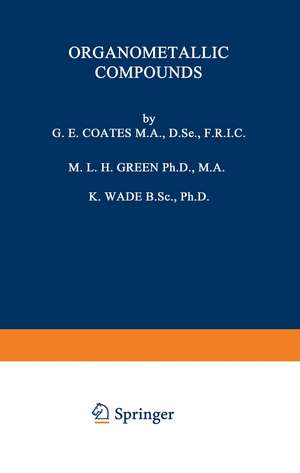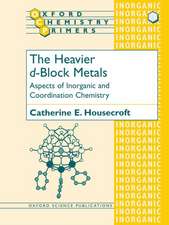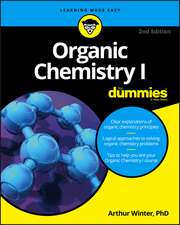Organometallic Compounds: Volume Two: The Transition Elements
Autor M. L. Greenen Limba Engleză Paperback – 13 noi 2013
Preț: 392.75 lei
Nou
Puncte Express: 589
Preț estimativ în valută:
75.15€ • 78.46$ • 62.20£
75.15€ • 78.46$ • 62.20£
Carte tipărită la comandă
Livrare economică 04-18 aprilie
Preluare comenzi: 021 569.72.76
Specificații
ISBN-13: 9789401168953
ISBN-10: 9401168954
Pagini: 396
Ilustrații: XIII, 376 p. 138 illus.
Dimensiuni: 152 x 229 x 21 mm
Greutate: 0.53 kg
Ediția:Softcover reprint of the original 1st ed. 1968
Editura: SPRINGER NETHERLANDS
Colecția Springer
Locul publicării:Dordrecht, Netherlands
ISBN-10: 9401168954
Pagini: 396
Ilustrații: XIII, 376 p. 138 illus.
Dimensiuni: 152 x 229 x 21 mm
Greutate: 0.53 kg
Ediția:Softcover reprint of the original 1st ed. 1968
Editura: SPRINGER NETHERLANDS
Colecția Springer
Locul publicării:Dordrecht, Netherlands
Public țintă
ResearchCuprins
to Volume Two.- Classification.- The 18-electron rule.- 1. Two-Electron Ligands.- A. Classification.- B. The preparation of olefin-transition metal complexes.- C. A molecular orbital description of the bonding in organo-metallic complexes.- D. A description of the bonding of 2-electron ligands to transition metals.- E. General comments of 2-electron ligands.- F. Particular complexes of metals with 2-electron ligands.- 2. Three-Electron Ligands.- A. Preparation of ?-enyl complexes.- B. The structure of ?-enyl complexes.- C. The ?-allyl metal bond.- D. Dynamic equilibria in allyl complexes.- E. The chemistry of particular ?-enyl complexes.- 3. Four-Electron Ligands.- A. Some differences between unconjugated and conjugated olefin ligands.- B. The bonding of 4-electron ligands to transition metals.- C. Particular studies.- 4. Five-Electron Ligands.- A. Cyclopentadienyl metal complexes.- B. ?-Cyclopentadienyl transition metal complexes.- C. Cyclopentadienide transition metal complexes.- D. The bonding in mono-?-cyclopentadienyl transition metal complexes.- E. ?-Cyclopentadienyl carbonyl complexes.- F. ?-Cyclopentadienyl nitrosyl complexes.- G. Brief notes on binuclear ?-cyclopentadienyl complexes containing bridging ligands.- H. ?-Cyclopentadienyl hydride complexes.- I. ?-Cyclopentadienyl halides and oxides.- J. Other 5-electron ligands.- K. The organic chemistry of ?-cyclopentadienyl transition metal complexes.- L. Some particular reactions.- 5. Six-Electron Ligands.- A. Arene transition metal complexes.- (a) Preparation.- B. Olefin 6-electron ligands.- C. Transition metal complexes containing ?-bonded heterocyclic ligands.- 6. Seven-Electron Ligands Mixed Sandwich Complexes Related Azulene Derivatives and Cyclo-Octatetraene Complexes.- A. 7-Electron ligands.-B. Mixed sandwich complexes.- C. Metal complexes formed from azulenes.- D. Cyclo-octatetraene complexes.- 7. One-Electron Ligands.- I.1. Hydrocarbon alkyl and aryl complexes.- I.2 Transition metal-acyl complexes.- I.3. ?-Cyclopentadienyl complexes.- II. Transition metal fluorocarbon complexes.- III. Transition metal acetytides and alkynyls.- 8. Organometallic Complexes Formed From Acetylenes.- A. Monoacetylene, mononuclear complexes: acetylenes as 2-elec-tron ligands.- B. Monoacetylene binuclear complexes: acetylenes as 4-electron ligands.- C. Monoacetylene trinuclear complexes.- D. Monoacetylene tetranuclear complexes.- E. Bis-acetylene mononuclear complexes.- F. Bis-acetylene trinuclear complexes.- G. Tris-acetylene mononuclear complexes.- H. Tris-acetylene binuclear complexes.- I. Miscellaneous.- 9. The Role of Organotransition Metal Complexes in Some Catalytic Reactions.- A. Some chemistry of transition metal hydride complexes.- B. Some catalytic reactions which involve hydrogen transfer: isomerization reactions.- C. Homogeneous hydrogenation of olefins and acetylenes.- D. Some dimerization oligomerization and polymerization reactions of olefins and acetylenes.- E. Hydroformylation and related carhonylation reactions.- F. Some general comments on the relationship between heterogeneous and homogeneous transition metal catalysts.- G. Miscellaneous.- Author.- Subject.- Crystal Structures>.







